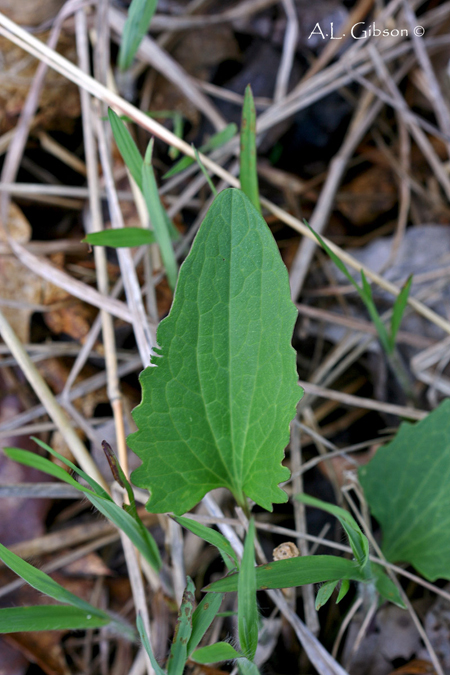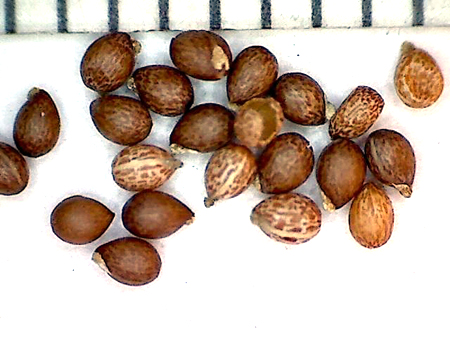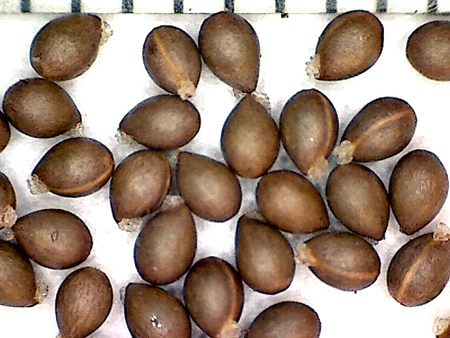Viola sagittata Aiton
Common names:
Arrow-leaved Violet, Arrowhead Violet
Synonyms:
Viola sagittata Aiton, Hort. kew., ed. 1, 3: 287. 1789. TYPE: ENGLAND: Hort. Fothergill (ex America Pensylvania), [s. d.], [J.
Fothergill s.n.] (LECTOTYPE (designated incorrectly as holotype by Nir Gil-ad, Boissiera 53:75. 1997; corrected by Ballard et al. 2020. Journal of the Botanical Research Institute of Texas 14(2): 227.): BM (BM001122805!, internet image!, MICH-photo).
Viola sagittata Aiton f. carlii Creutz, Wild Fl. 35: 9, fig. 2. 1959
Viola sagittata Aiton var. glabra Pennell, Bartonia 12: 19. 1931
Viola dentata Pursh, Fl. Amer. sept. 1: 172. 1813
Description:
Acaulescent rosulate perennials from thick rhizome, ≤ 29 cm tall; foliage and peduncles green (lower surface of leaf blades commonly purple-tinged in serpentine populations), leaves glabrous or hirtellous, peduncles glabrous; mostly heterophyllous, leaves erect, leaf blades during chasmogamous flower undivided or with small basal teeth or slender lobes, in fruit commonly pedately divided into 5(7) segments, with lateral primary divisions each divided into 2(3) slender teeth or lobes, these le; 1/4 length of the midrib; stipules free, irregularly glandular-fimbriate; largest leaf blades ≤ 83 × 33 mm, during chasmogamous flower narrowly elliptical or ovate-lanceolate, during fruit becoming sagittate to lance-triangular, base subtruncate to hastate, margins serrate proximally but subentire distally, eciliate or ciliate, apex acute to acuminate; chasmogamous peduncle held above the leaves; chasmogamous flower ≤ 26 mm; calyx glabrous, eciliate; lowest sepals linear-lanceolate to lance-triangular, acuminate; auricles mostly prominent and entire, elongating to 3 mm in fruit; corolla blue to purple, throat white; spur short-globose; lateral petals densely bearded with filiform hairs, spurred petal densely bearded; cleistogamous flowers produced after chasmogamous, the peduncle erect and nearly or quite as long as the petioles; capsule (6)8–14 mm, green drying tan or green-brown, unspotted, glabrous; seeds 1.2–1.8 × 0.8–1.3 mm, medium pinkish-brown or medium to dark red-brown, unspotted or with weak small blotches; 2n=54.
Similar species:
Viola emarginata, Viola fimbriatula, [Viola lovelliana], Viola septemloba
Ecology:
Seasonally moist to wet sandy acidic soils in meadows, lakeshores, swamp margins, prairies, interdunal swales, quarries and borrow pits, and forest clearings, occasionally in closed-canopy oak or oak-pine woodlands and pine plantations.
Distribution:
Widespread in e. North America, sw. QC to s. MN, south to GA, e. TX and OK.
Rarity:
None.
Phenology:
Chasmogamous flower May–July, chasmogamous fruit May–June (August), cleistogamous fruit July–August.
Affinities:
This species belongs to the Acaulescent Blue Violet lineage, sect. Nosphinium W.Becker, subsect. Boreali-Americanae (W.Becker) Gil-ad, in the Sagittata species group.
Hybrids:
Hybridizes with V. affinis (Brainerd 1906b, 1910b, 1924, House 1924, Russell and Risser 1960, Russell 1965), V. baxteri (Harvey Ballard pers. comm.), V. brittoniana (Brainerd 1906b, 1924, House 1906b, 1924), V. communis [or possibly V. "sororia glabrous" or V. "sororia hirsutula-like"] (Brainerd 1906b, 1924, House 1924), V. cucullata (Brainerd 1906b, 1924), V. emarginata sensu stricto (Brainerd 1906b, 1924), V. fimbriatula (Greene 1898, Pollard 1898, Brainerd 1906b, 1907a, 1924, House 1924, Cinq-Mars 1966, Haines et al. 2011), V. floridana [V. rosacea] (Brainerd 1924), V. hirsutula (Henry 1953a), V. nephrophylla (Gaiser and Moore 1966), V. palmata var. triloba (Brainerd 1906b, 1913c, 1924, House 1924), V. pedatifida (Brainerd 1913a, 1924, Ballard 2013), V. sororia sensu stricto (Brainerd 1924), and V. subsinuata (Brainerd 1906b, 1913c, 1924, Dowell 1910, House 1924). Brainerd reported that these exhibit intermediate or recombinant characteristics of foliage, chasmogamous flowers, cleistogamous capsules and seeds (where these did not abort). All hybrids fail to reproduce by chasmogamous flowers. Most hybrids express a substantial or severe reduction in proportion of viable seeds. The hybrid with V. emarginata sensu stricto is widely variable, some plants almost fully fertile and others producing few viable seeds; the hybrid with V. fimbriatula is largely or fully fertile in producing a large proportion of viable seeds.
Comments:
The brief protologue described in Hortus Kewensis stated that the plant was “Nat. of Pensylvania. Introd. 1775, by John Fothergill, M.D.” The protologue suggests a single collection from the Royal Botanic Garden at Kew. However, Stafleu and Cowan (1976) observed that Fothergill’s garden collections were deposited at both BM and LINN. The sheet at BM has two collections on it; BM001122805 matches “1” of the handwritten note on the back with the statement “Hort. Fothergill (ex America Pensylvania)”; BM000617472 matches “2” of the note, “Hort. Kew 1778.” Both are presumably original material. Harvey Ballard previously incorrectly annotated the sheet as holotype. Gil-ad also annotated the sheet as the holotype but later restricted his designation to the three leaves and cleistogamous material of BM001122805 (Gil-ad 1995, 1997). Gil-ad’s designation was corrected to lectotype by Ballard et al. (2020). The other Fothergill collection, BM000617472, remains a syntype.
Brainerd (1921b), Brainerd Baird (1942), Fernald (1950), Henry (1953a), Alexander (1963), Russell (1965), Strausbaugh and Core (1978), Swink and Wilhelm (1979), Gil-ad (1995, 1997, 1998) adopted a narrowly defined V. sagittata that was distinct from V. fimbriatula Sm. Scoggan (1978), McKinney (1992), Ballard (1995, 2000, 2013), McKinney and Russell (2002), Voss and Reznicek (2012), Weakley et al. (2012), and Little and McKinney (2015) reduced V. fimbriatula to V. sagittata Aiton var. ovata (Nutt.) Torr. & A. Gray, while Gleason and Cronquist synonymized V. fimbriatula under V. sagittata with no recognition of infraspecific taxa. Brainerd, Brainerd Baird, Fernald, Alexander, and Strausbaugh and Core also distinguished V. sagittata from V. emarginata (Nutt.) Leconte. Russell and Risser (1960) and Russell (1965) misapplied the name V. emarginata to refer to hybrid plants of V. affinis × V. sagittata, but he unwittingly included bona fide V. emarginata (based on his annotations) in a more broadly delimited V. sagittata. McKinney, McKinney and Russell (2002), Haines et al. (2011), Weakley et al. (2012), and Little and McKinney (2015) explicitly included V. emarginata in their synonymy of V. sagittata. Given the several consistent morphological differences in leaves, chasmogamous flowers, cleistogamous capsules and seeds, as well as divergent ecological niches inhabited by the three taxa, the narrowest delimitation of V. sagittata as a species distinct from V. fimbriatula and the V. emarginata species complex is followed here.
The present species is somewhat variable in foliage indument and degree of leaf blade cutting, with the extremes most obvious in fruiting plants. The wholly glabrous sagittate extreme bears summer leaf blades with 2-3 linear-falcate basal lobes on each side, and it appears to be more common near the southern shores of the Great Lakes and along the Atlantic and Gulf Coastal Plains, where it is most characteristic of seasonally to permanently wetter microsites such as ditches, edges of sandy lakeshores and lakeplain wet prairies. The other extreme constitutes the majority of midwestern plants, with moderately hirtellous foliage and occasionally sparsely hirtellous peduncles and sparsely ciliate sepals, the leaf blades with somewhat less pronounced basal lobes or with merely slightly larger basal teeth or shallow basal incisions–; these plants are common in drier microsites such as sand barrens and drier sandy old fields. This latter extreme represents the older names V. sagittata var. subsagittata (Greene) Pollard or V. subsagittata Greene, and it has frequently been the cause of confusion with V. fimbriatula. ". Intermediate" plants with all manner of expressions of leaf blade lobing and indument are found throughout the zone of overlap, with these features sometimes varying somewhat within populations and among populations in the Great Lakes region. Both are included under V. sagittata without formal recognition. As Brainerd and others have suggested, this local and regional polymorphism might be the product of past hybridization between Viola fimbriatul and V. sagittata, but the two are now quite consistently divergent in several vegetative and reproductive features, and they are maintained here as distinct species (as is V. emarginata).
Literature Cited:
Alexander, E. J. 1963. Violaceae. In Gleason, H. A., The new Britton and Brown illustrated flora of the northeastern United States and adjacent Canada. Hafner Publishing Co., Inc., New York, NY. 552-567.
Ballard Jr., H. E. 1995 ["1994"]. Violets of Michigan. Michigan Botanist 33: 131-199.
Ballard Jr., H. E. 2000. Violaceae. In Rhoads, A. (ed.). Flora of Pennsylvania. University of Pennsylvania Press, Philadelphia, PA. 700-710.
Ballard Jr., H. E. 2013. Violaceae. In Yatskievych, G., Flora of Missouri. Missouri Botanical Garden Press, St. Louis, MO. 1218-1243.
Brainerd, E. 1906b. Hybridism in the genus Viola,-II. Rhodora 8: 6-10.
Brainerd, E. 1907a. Mendel’s law of dominance in the hybrids of Viola. Rhodora 9: 211-216.
Brainerd, E. 1910b. The evolution of new forms in Viola through hybridism. American Naturalist 44: 229-236.
Brainerd, E. 1913a. Four hybrids of Viola pedatifida. Bulletin of the Torrey Botanical Club 40: 249-260.
Brainerd, E. 1913c. Notes on new or rare violets of northeastern America. Rhodora 15: 112-115.
Brainerd, E. 1921b. Violets of North America. Vermont Agricultural Experiment Station Bulletin 224: 1-172.
Brainerd, E. 1924. The natural violet hybrids of North America. Vermont Agricultural Experiment Station Bulletin 239.
Brainerd Baird, V. 1942. Wild violets of North America. University of California Press, Berkeley, CA.
Cinq-Mars, L. 1966. Mise au point sur les violettes (Viola spp.) du Québec. Naturaliste canadien 93: 895-958.
Fernald, M. L. 1950. Violaceae. In Gray’s Manual of Botany, 8th ed. American Book Company, New York, NY. 1022-1042.
Gaiser, L. O., and R. J. Moore. 1966. A survey of the vascular plants of Lambton County, Ontario. Plant Res. Inst. Can. Dept. Agric. Ottawa, Ont. 122 pp.
Gil-ad, N. L. 1995. Systematics and evolution of Viola L. subsection Boreali-Americanae (W. Becker) Brizicky. Ph.D. dissertation. University of Michigan, Ann Arbor, MI.
Gil-ad, N. L. 1997. Systematics of Viola subsection Boreali-Americanae. Boissiera 53: 1-130.
Gil-ad, N. L. 1998. The micromorphologies of seed coats and petal trichomes of the taxa of Viola subsect. Boreali-Americanae (Violaceae) and their utility in discerning orthospecies from hybrids. Brittonia 50: 91-121.
Gleason, H. A., and A. Cronquist. 1991. Violaceae. In Manual of vascular plants of northeastern United States and adjacent Canada, 2nd ed. New York Botanical Garden, Bronx, NY. 157-163.
Greene, E. L. 1898c. New or noteworthy violets. Pittonia 3: 313-318.
Haines, A., E. Farnsworth, and G. Morrison. 2011. Violaceae. In Flora Novae Angliae. Yale University Press, New Haven, CT. 873-886.
Henry, L. K. 1953a. The Violaceae in western Pennsylvania. Castanea 18(2): 37-59.
House, H. D. 1906b. The violets and violet hybrids of the District of Columbia and vicinity. Rhodora 8: 117-122, plates 71-72.
House, H. D. 1924. Annotated list of the ferns and flowering plants of New York state. Family 83 Violaceae. New York State Museum Bulletin 254: 499-512.
Little, R. J., and L. E. McKinney. 2015. Violaceae. In Flora of North America: Cucurbitaceae to Droseraceae, 106. Oxford University Press, New York, NY.
McKinney, L. E. 1992. A taxonomic revision of the acaulescent blue violets (Viola) of North America. Sida, Botanical Miscellany 7: 1-60.
McKinney, L. E., and N. H. Russell. 2002. Violaceae of the southeastern United States. Castanea 67: 369-379.
Pollard, C. L. 1898. Further observations on the eastern acaulescent violets. Botanical Gazette 26: 325-342.
Russell, N. H. 1965. Violets (Viola) of the central and eastern United States: An introductory survey. Sida 2: 1-113.
Russell, N. H., and A. C. Risser Jr. 1960. The hybrid nature of Viola emarginata. Brittonia 12: 298-305.
Scoggan, H. J. 1978. Violaceae. In Flora of Canada, Part 3–Dicotyledoneae (Saururaceae to Violaceae). National Museums of Canada. Ottawa, Canada. 1103-1115.
Stafleu, F. A., & R.S. Cowan. 1976. Taxonomic literature: a selective guide to botanical publications and collections with dates, commentaries and types, Second edition, Volume 1: A-G. Bohn, Scheltema & Holkema, Utrecht, The Netherlands. [https://www.sil.si.edu/DigitalCollections/tl-2/].
Strausbaugh, P. D., and E. L. Core. 1978. Violaceae. In Flora of West Virginia, 2nd ed. Seneca Books, Inc., Morgantown, WV. 644-658.
Swink, F., and G. Wilhelm. 1979. Violaceae. In Plants of the Chicago region, 2nd ed. revised and expanded. Morton Arboretum, Lisle, IL. 384, 801-810.
Voss, E. G., and A. A. Reznicek. 2012. Violaceae. In Field manual of Michigan flora. The University of Michigan Press, Ann Arbor, MI. 913-922.
Weakley, A. S., J. C. Ludwig, and J. F. Townsend. 2012. Violaceae. In Flora of Virginia. BRIT Press, Fort Worth, TX. 963-975.

Chasmogamous flowering habit by Andrew Gibson, "Buckeye Botanist" website

Leaf by Andrew Gibson, "Buckeye Botanist" website

Chasmogamous flower front view by Andrew Gibson, "Buckeye Botanist" website

Seeds from herbarium specimen: MA, Arlington Heights, Abundant in recent clearing, 5 Jun 1904, M. L. Fernald s.n. (NY)

Seeds from herbarium specimen: Transplanted from OH, Scioto Co., Rocky Fork Cemetery, 28 Jun 2015, H. Ballard15-044X (BHO)

Map by the Biota of North America Program